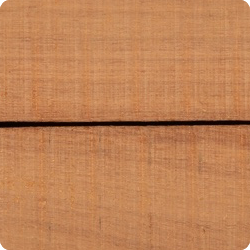Detailed Specs: Kakaralli
Scientific Name: Eschweilera spp
Family: Lecythidaceae
Other Names: Oxito, Olleto (Panema), Coco De Mona, Montanero (Venezuela), Coco cristal, tete congo (Columbia) Haudan Kakeralli (Guyana), Oemanbarklak, Manbarak (Suriname), Mata-mata, Ateraba, Jarana (Brazil)
The Tree
Most species reach heights of 90-120 feet with trunk diameters of 16 to 24 inches, sometimes up to 40 inches. Boles are moderately well formed ranging from 40-60 feet long often fluted or slightly buttressed.
The Wood
General Characteristics: The heartwood ranges from colours such as light brown, greyish brown, reddish brown or a brownish buff and sometimes has black streaks. The Sapwood is light-greyish brown or yellowish. Its luster is low and the grain is typically straight with a fine uniform texture and no distinctive odour or taste. Also, depending on the species, silica content may be as high as 2.4%.
Weight: Basic specific gravity (ovendry weight/green volume) varies with species from 0.62-0.95, mostly about 0.85; mostly about 0.85; air dry density ranges from 48-74pcf, averaging about 64.
Drying and Shrinkage: The wood is rated as fairly difficult to air-season, drying rates are slow to moderate. Warp and checking are rated as slight to moderate depending on the species. No kiln schedule data is available. Shrinkage from green to oven dry typicall y: radial 5.8%; tangential: 10.3 and volumetric 15.9%.
Working Properties: Most of the species are difficult to work due to its high density and silica content, this is for the exception of E. tenax. Specialty tip cutters are suggested.
Mechanical Properties: (First two sets of data based on the 2-in standard; the 3rd on the 1inch standard.
|
Moisture |
Bending Strength (psi) |
Modules of Elasticity (1000 psi) |
Maximum Crushing Strength (psi) |
| Green (73)
12% Green (73) 12% 12% (24) |
10,870
14,460 17,110 26,470 30,300 |
1,480
1,760 2,700 3,140 3,180 |
3,880 6,370 7,340 11,210 13,400 |
Janka hardness for green material ranges from 1280 lb to 2480 lb. Forest Products Laboratory toughness average of green and dry material ranges from 239-365 in-lb. (5/8-in specimen).
Durability: Most species are highly resistant to attack by both black and white rot fungi, termites and insects. Also, this wood type has gained recognition for its high degree of resistance to marine borers. However, dry wood termite resistance is dependent on t he species.
Distribution: About 60 species are distributed from eastern Brazil through the Amazon basins to the Guianas, Trinidad and Costa Rica.
Preservation: It is highly resistant to decay, termites and insects. Also, has poor treatability.
Uses: Suitable for heavy carpentry, industrial flooring, sleepers, shipbuilders, poles and posts, turnery, frame construct ion and marine construction. It can be substituted for greenheart in marine construction and can also be used in the same capacity as Bullet wood.
References
– Chundnoff, Martin, “Tropical Timbers of the World.” USDA Forest Service Ag. Handbook No.607.



